10 Famous Landmarks You Cannot Miss Visiting In South Africa
By: Priyanka Maheshwari Wed, 21 June 2023 10:36:23
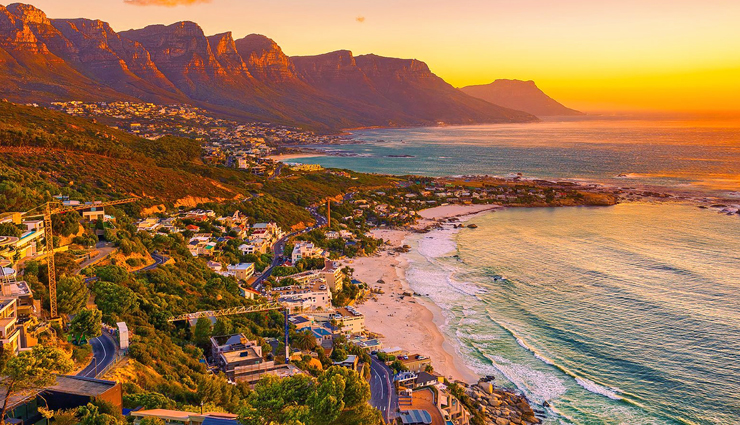
South Africa, officially known as the Republic of South Africa, is a diverse and vibrant country located at the southernmost tip of the African continent. It is often referred to as the "Rainbow Nation" due to its multicultural society and rich cultural heritage.
South Africa has a fascinating history that has shaped its present-day identity. The country's history is marked by the arrival of various indigenous communities, colonization by the Dutch and British, and the struggle against apartheid—a system of racial segregation and discrimination that lasted for decades.
With a population of over 59 million people, South Africa is home to various ethnic groups, including Zulu, Xhosa, Afrikaans, Sotho, and many others. This diversity is reflected in the country's languages, with 11 official languages recognized, including English, Afrikaans, Zulu, Xhosa, and Sotho.
The natural beauty of South Africa is breathtaking, ranging from stunning coastlines along the Indian and Atlantic Oceans to breathtaking landscapes, such as the iconic Table Mountain and the picturesque Drakensberg Mountains. The country is also renowned for its diverse wildlife, with several national parks and game reserves offering the opportunity to observe animals like lions, elephants, rhinos, and giraffes in their natural habitats.
South Africa has a mixed economy with a well-developed infrastructure and a rich abundance of natural resources. It is the largest economy in Africa, with sectors such as mining, manufacturing, agriculture, and tourism playing significant roles. The country has made notable strides in recent years to address economic inequality and improve access to education and healthcare.
While South Africa offers remarkable opportunities and attractions, it also faces social and economic challenges. High levels of inequality, unemployment, and crime are among the issues the country is working to address.
Despite the challenges, South Africa is known for its resilience, cultural vibrancy, and spirit of unity. It has hosted major international events like the 2010 FIFA World Cup, showcasing its ability to bring people together and celebrate diversity.
Whether it's exploring its diverse landscapes, immersing oneself in its rich cultural heritage, or engaging with its warm and friendly people, South Africa offers a unique and captivating experience that continues to draw visitors from around the world.
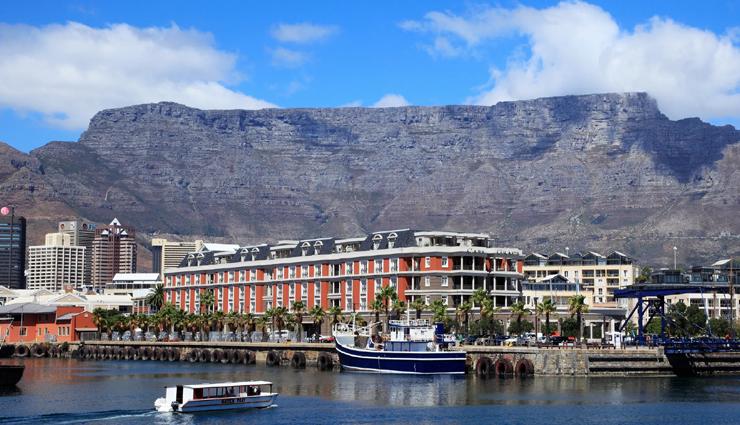
# Table Mountain
Table Mountain is one of the most iconic landmarks in South Africa and is located in the city of Cape Town. It is a flat-topped mountain that dominates the city's skyline and is a prominent feature of Table Mountain National Park, which is a designated UNESCO World Heritage site.
Here are some key details about Table Mountain:
- Geology and Formation: Table Mountain is approximately 1,085 meters (3,558 feet) in height and is composed mainly of sandstone. It was formed over millions of years through geological processes and erosion. The unique flat-topped shape is the result of the mountain's hard sandstone cap being more resistant to erosion compared to the softer rocks surrounding it.
- Cableway: One of the most popular ways to reach the summit of Table Mountain is by using the Table Mountain Aerial Cableway. The cableway offers a breathtaking ride up the mountain, providing panoramic views of Cape Town, the coastline, and the surrounding natural beauty. The cableway rotates 360 degrees during the ascent, ensuring that passengers can enjoy the incredible vistas from all angles.
- Flora and Fauna: Table Mountain is known for its rich biodiversity and is home to a wide variety of plant and animal species. The mountain is covered in unique vegetation known as fynbos, which is a type of shrubland found only in the Western Cape of South Africa. It is a hotspot for plant diversity, with numerous endemic species. The mountain is also home to various animals, including dassies (rock hyraxes), porcupines, and a variety of bird species.
- Hiking and Outdoor Activities: Table Mountain offers numerous hiking trails that cater to different fitness levels and preferences. The routes range from easy walks to more challenging climbs, providing opportunities for visitors to explore the mountain's natural beauty and enjoy stunning views along the way. Rock climbing, abseiling, and paragliding are other popular activities for adventure enthusiasts.
- Tourist Attraction: Table Mountain is a major tourist attraction in South Africa and draws millions of visitors each year. It offers breathtaking views of Cape Town, Robben Island, the Atlantic Ocean, and the surrounding landscape. On a clear day, it is possible to see as far as Cape Point, which is located at the southern tip of the Cape Peninsula.
Table Mountain holds significant cultural and historical importance for the people of Cape Town, and it is deeply intertwined with the identity of the city. It is not only a natural wonder but also a symbol of resilience and pride for the local community.

# Robben Island
Robben Island is a small island located approximately 7 kilometers (4.3 miles) off the coast of Cape Town, South Africa. The island is best known for its historical significance as a place of imprisonment during the apartheid era. Here is some information about Robben Island:
- Apartheid Prison: Robben Island served as a political prison for nearly four centuries, with its most notorious period being during the apartheid regime in South Africa (1948-1994). The apartheid government used the island as a place of banishment and confinement for political prisoners, particularly those who fought against racial segregation and discrimination. Prominent anti-apartheid leaders, including Nelson Mandela, were held captive on Robben Island for many years.
- Nelson Mandela: The most famous inmate of Robben Island was Nelson Mandela, the iconic anti-apartheid leader and South Africa's first black president. Mandela was imprisoned on the island for 18 of his 27 years of incarceration. During his time on Robben Island, Mandela and other political prisoners endured harsh conditions and engaged in resistance against the oppressive regime. Mandela's cell, along with other significant locations on the island, has now become a museum and is open to visitors.
- UNESCO World Heritage Site: In recognition of its historical and cultural significance, Robben Island was designated as a UNESCO World Heritage site in 1999. The island serves as a symbol of the triumph of human spirit over oppression and a reminder of the struggle for freedom and equality in South Africa.
- Robben Island Museum: Today, Robben Island is operated as a museum and heritage site. Visitors can take guided tours that provide insights into the island's history, including the prison complex, the limestone quarry where prisoners performed hard labor, and the various landmarks associated with the anti-apartheid struggle. The tours are often led by former political prisoners, offering firsthand accounts and personal stories of their experiences on the island.
- Natural and Wildlife Conservation: In addition to its historical significance, Robben Island is also home to a diverse range of plant and animal species. The island is an important breeding ground for seabirds, including African penguins, and supports various coastal and marine ecosystems. Efforts are being made to protect the island's natural heritage and promote environmental conservation alongside its historical preservation.
Robben Island stands as a powerful testament to the resilience and sacrifice of those who fought against apartheid. It serves as a place of remembrance, education, and reflection, allowing visitors to gain a deeper understanding of South Africa's tumultuous past and the ongoing journey towards reconciliation and justice.
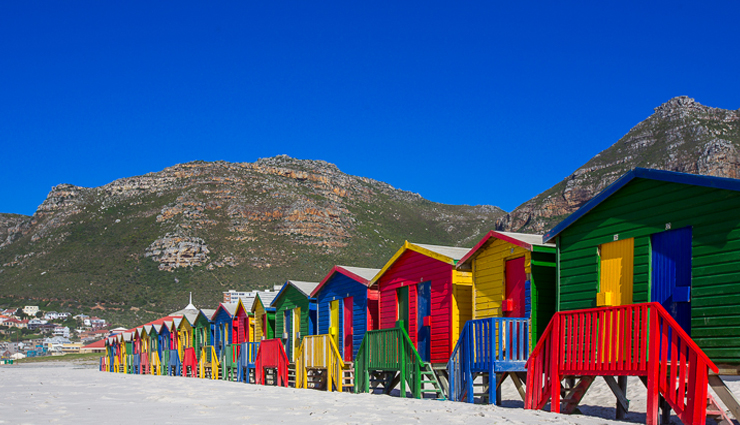
# Muizenberg’s beach huts
Muizenberg's beach huts are colorful and iconic structures located along the beachfront of Muizenberg, a coastal suburb in Cape Town, South Africa. Here's some information about Muizenberg's beach huts:
- History and Heritage: The beach huts in Muizenberg have a long-standing history dating back to the early 20th century. They were originally built as changing rooms and storage facilities for beachgoers in the Victorian era. Over time, the huts became a distinctive feature of the beach, creating a vibrant and nostalgic atmosphere.
- Colorful Architecture: The beach huts are known for their vibrant colors, with each hut painted in a different shade. The colorful facades create a visually appealing backdrop against the sandy beach and azure waters, making it a popular spot for photography and a symbol of the beach's charm.
- Iconic Photography Location: Muizenberg's beach huts have become an iconic photography location, attracting tourists and locals alike. The vibrant colors and picturesque setting make it a sought-after spot for capturing memorable images and creating a sense of nostalgia.
- Popular Surfing Destination: Muizenberg is renowned for its excellent surfing conditions, and the beach huts add to its appeal as a surfing destination. The huts provide a visually appealing backdrop for surfers and contribute to the unique atmosphere of the beach.
- Cultural Significance: The beach huts hold cultural significance as they represent a bygone era and evoke a sense of nostalgia for visitors. They have become synonymous with Muizenberg's identity and serve as a reminder of the area's rich history and heritage.
- Beachfront Experience: The beach huts are situated along the beach promenade, creating a lively and enjoyable atmosphere for beachgoers. Visitors can rent the huts, which are equipped with basic amenities, to change into swimwear or store their belongings while enjoying a day at the beach.
The beach huts of Muizenberg have become an iconic symbol of the area, attracting visitors who are drawn to their colorful charm and the nostalgic ambiance they create. Whether it's capturing memorable photographs, enjoying a day at the beach, or immersing oneself in the cultural heritage of the area, the beach huts of Muizenberg offer a unique and delightful experience for all who visit.
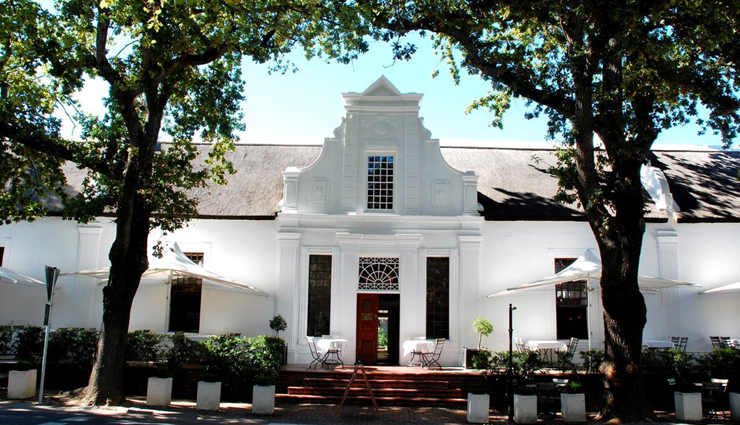
# Cape Dutch homesteads of the Winelands
The Cape Dutch homesteads of the Winelands in South Africa are historic architectural treasures found in the wine-producing regions near Cape Town. Here's some information about these remarkable structures:
- Architectural Style: Cape Dutch architecture is a distinctive style that originated in the Cape Colony during the 17th and 18th centuries. It combines elements of Dutch and German building traditions with local adaptations to suit the Cape's climate and cultural context. Cape Dutch homesteads are characterized by symmetrical gable ends, thatched or tiled roofs, whitewashed walls, and ornate gables with decorative details.
- Historical Significance: The Cape Dutch homesteads played a significant role in the development of the Cape Colony. They were primarily built by European settlers, known as the Cape Dutch, who established farms and vineyards in the region. These homesteads served as family residences, agricultural centers, and symbols of status and wealth during the Dutch colonial era.
- Winelands Region: The Winelands region is located in the Western Cape province of South Africa, encompassing several towns and valleys renowned for their vineyards and wine production. Stellenbosch, Franschhoek, and Paarl are among the prominent towns in the area, and they boast numerous Cape Dutch homesteads that have been preserved or restored.
- Architectural Features: Cape Dutch homesteads often feature unique architectural elements. The front gables, known as "holbol" gables, have a characteristic rounded shape resembling a half-moon. These gables are usually decorated with intricate motifs, including geometric patterns, vines, flowers, and other ornamental details. Some homesteads may also have thatched roofs, while others have replaced them with more durable materials like tiles.
- Tourism and Preservation: The Cape Dutch homesteads have become a significant tourist attraction in the Winelands region. Many of these historic buildings have been carefully preserved, converted into museums, guesthouses, or wine estates, and offer visitors a glimpse into the Cape's colonial past and architectural heritage. The homesteads are often surrounded by beautiful gardens and vineyards, enhancing the overall ambiance and appeal.
- Cultural Heritage: The Cape Dutch homesteads are not only architectural treasures but also reflect the cultural heritage of South Africa. They represent the influences of European settlers, the blending of cultures, and the agrarian history of the region. These homesteads serve as reminders of the early colonial period and the legacy of winemaking that continues to thrive in the Winelands today.
Visiting the Cape Dutch homesteads in the Winelands provides an opportunity to appreciate the unique architectural style, delve into the region's history, and indulge in the beauty of the surrounding landscapes and wine culture.

# Southernmost Tip of Africa
The southernmost tip of Africa is a geographical location located in South Africa, known as Cape Agulhas. Here's some information about the southernmost tip of Africa:
- Location: Cape Agulhas is situated approximately 170 kilometers (105 miles) southeast of Cape Town, in the Western Cape province of South Africa. It is where the Atlantic Ocean and the Indian Ocean meet.
- Geographical Significance: Cape Agulhas holds the distinction of being the southernmost point on the African continent. It is also considered the dividing line between the Atlantic and Indian Oceans, with the official demarcation marked by a geographical monument.
- Cape Agulhas Lighthouse: The Cape Agulhas Lighthouse is a prominent landmark at the southernmost tip. It was built in 1848 and stands at a height of 27 meters (88 feet). The lighthouse played a crucial role in guiding ships navigating the treacherous waters around the Cape.
- Maritime History: Cape Agulhas has a significant maritime history. The area was notorious for its hazardous conditions, including strong currents, rocky reefs, and unpredictable weather patterns. Many ships, including explorers and trading vessels, had to pass through these perilous waters during their voyages.
- Natural Beauty: Cape Agulhas is known for its scenic beauty and rugged coastline. Visitors can enjoy breathtaking views of the ocean and the surrounding landscape. The area is also home to diverse flora and fauna, including coastal fynbos vegetation and birdlife.
- Tourism and Activities: Cape Agulhas has become a popular tourist destination, attracting visitors who want to experience the southernmost point of the African continent. Tourists can explore the Cape Agulhas Lighthouse and its museum, walk along the rugged coastline, and take in the panoramic views. The area also offers opportunities for whale watching, fishing, hiking, and enjoying the beaches.
Visiting the southernmost tip of Africa at Cape Agulhas allows travelers to experience a sense of geographical significance, appreciate the natural beauty of the area, and connect with the maritime history that has shaped the region. It is an intriguing destination that showcases the meeting of two oceans and offers a unique and memorable experience.
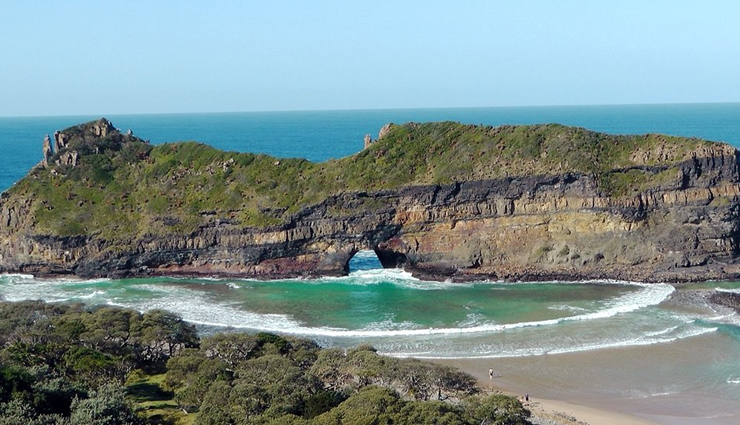
# Hole in the Wall
The Hole in the Wall is a distinctive geological formation located on the Wild Coast of the Eastern Cape province in South Africa. Here's some information about the Hole in the Wall:
- Location: The Hole in the Wall is situated near Coffee Bay, a small coastal village along the Indian Ocean. It is approximately a 10-hour drive from Johannesburg and a 6-hour drive from Durban.
- Geological Formation: The Hole in the Wall is a natural archway that has been carved into a cliffside by the powerful waves of the ocean over thousands of years. The hole is formed by the erosive action of the waves, creating a large opening that separates a rocky promontory from the mainland.
- Legend and Folklore: The Hole in the Wall holds cultural and historical significance for the Xhosa people, who inhabit the area. According to local legend, a young maiden was fleeing from an arranged marriage when she encountered turbulent waters. As she swam, a giant fish emerged from the sea and created the hole, allowing her to pass through safely. The hole is thus seen as a symbol of protection and a connection between the spiritual and physical worlds.
- Scenic Beauty: The Hole in the Wall is renowned for its scenic beauty. The dramatic rock formation, set against the backdrop of the ocean, creates a picturesque and awe-inspiring sight. The area around the Hole in the Wall is also characterized by rugged cliffs, golden beaches, and rolling hills, offering visitors breathtaking views and opportunities for hiking and exploration.
- Outdoor Activities: The Hole in the Wall is a popular destination for outdoor enthusiasts. Visitors can take scenic walks along the coastline, go swimming in the tidal pools, and enjoy birdwatching in the surrounding nature reserves. The area is also known for its excellent surfing conditions, attracting surfers from around the world.
- Cultural Tourism: The Hole in the Wall provides an opportunity to engage with the local Xhosa culture. Visitors can interact with the Xhosa communities, learn about their traditions, and even witness traditional ceremonies and dances. Local guides are available to provide insights into the cultural significance and history of the area.
The Hole in the Wall is not only a geological marvel but also a place of cultural significance and natural beauty. It offers visitors a chance to appreciate the power of nature, immerse themselves in local traditions, and enjoy the breathtaking scenery of the Wild Coast.

# Constitution Hill
Constitution Hill is a historic and significant site located in Johannesburg, South Africa. Here's some information about Constitution Hill:
- Historical Significance: Constitution Hill is a former prison complex that played a crucial role in South Africa's history, particularly during the apartheid era. It was originally built as a military fort, known as the Old Fort, by the British colonial government in the late 19th century. Over time, it evolved into a notorious prison where political activists, including Nelson Mandela and Mahatma Gandhi, were once incarcerated.
- Apartheid Era: During the apartheid era (1948-1994), Constitution Hill served as a prison for political prisoners, dissenters, and opponents of the oppressive apartheid regime. It symbolized the struggle for human rights, freedom, and democracy in South Africa. The prison's segregation policies and harsh conditions further highlighted the injustices and racial discrimination faced by the majority of the population.
- Constitutional Court: Today, Constitution Hill is the seat of South Africa's Constitutional Court, the highest court in the country. The Constitutional Court is responsible for safeguarding the rights enshrined in the South African Constitution and upholding the principles of justice, equality, and human dignity. The presence of the court on this historic site represents the country's progress towards democracy and reconciliation.
- Heritage Site and Museums: Constitution Hill has been transformed into a heritage site and cultural precinct that aims to educate visitors about South Africa's history, human rights, and the ongoing struggle for social justice. The site includes museums and exhibitions that provide insights into the country's past, including the apartheid era and the journey towards democracy. The museums showcase the stories of the prisoners and the hardships they endured.
- Tours and Events: Visitors to Constitution Hill can take guided tours to explore the various buildings and learn about the site's historical significance. The tours often include visits to the prison cells, the Constitutional Court, and the museums. Constitution Hill also hosts cultural events, exhibitions, and educational programs that promote dialogue and awareness around human rights issues.
- Symbol of Hope: Constitution Hill stands as a powerful symbol of hope, transformation, and the resilience of the South African people. It represents the country's commitment to justice, equality, and the protection of human rights. By engaging with its history, visitors can gain a deeper understanding of South Africa's journey towards a democratic society and the importance of upholding fundamental rights and freedoms.
Constitution Hill is a place of remembrance, reflection, and learning that offers visitors a chance to engage with South Africa's complex past and witness the transformative power of the constitution in shaping the nation's future.

# Cradle of Humankind
The Cradle of Humankind is a renowned UNESCO World Heritage site located in Gauteng Province, South Africa. Here's some information about the Cradle of Humankind:
- Geological Significance: The Cradle of Humankind is a complex of limestone caves and dolomitic rock formations that have yielded a wealth of paleontological and archaeological discoveries. It is considered one of the world's most significant fossil-bearing sites, providing crucial insights into the origins and evolution of humankind.
- Human Ancestors: The region has yielded numerous fossilized remains of early hominids, including the famous Australopithecus africanus specimen "Mrs. Ples" and "Little Foot," a nearly complete Australopithecus skeleton dating back over three million years. These findings have contributed significantly to our understanding of human evolution.
- Sterkfontein Caves: The Sterkfontein Caves, a prominent component of the Cradle of Humankind, have been extensively excavated and studied. They have produced some of the most significant hominid fossils ever discovered, leading to groundbreaking research on human ancestry and evolution.
- Maropeng Visitor Centre: The Cradle of Humankind is home to the Maropeng Visitor Centre, which serves as an educational and interactive hub. The center provides visitors with an immersive experience, showcasing the scientific discoveries made in the area through interactive exhibits, displays, and multimedia presentations. It offers insights into human evolution, the geological history of the region, and the importance of preserving our natural heritage.
- Tumulus Building: The Maropeng Visitor Centre features a unique architectural structure known as the Tumulus. Resembling a massive burial mound, the Tumulus houses a museum that chronicles the journey of humankind, from our earliest ancestors to modern humans.
- Sustainable Development and Conservation: The Cradle of Humankind is committed to sustainable development and environmental conservation. Efforts are made to protect the fossil sites, promote responsible tourism, and engage local communities in the preservation of this invaluable heritage.
- Tourism and Scientific Research: The Cradle of Humankind attracts visitors from around the world, including scientists, researchers, and tourists interested in human evolution and paleontology. Visitors can explore the Sterkfontein Caves, join guided tours, and learn about the ongoing scientific research conducted in the area.
The Cradle of Humankind is a treasure trove of scientific discoveries that shed light on our shared human origins. It offers a unique opportunity to explore the ancient past, marvel at the fossils that provide glimpses into our ancestral heritage, and gain a deeper appreciation for the remarkable journey of humankind.

# Union Buildings
The Union Buildings, located in Pretoria, South Africa, are an iconic architectural and political landmark. Here's some information about the Union Buildings:
- Symbol of Democracy: The Union Buildings are the official seat of the South African government and the office of the President. They symbolize the country's democracy and serve as a focal point for political activities and national events.
- Architectural Design: Designed by Sir Herbert Baker, a prominent British architect, the Union Buildings were constructed between 1909 and 1913. The architectural style is neoclassical, featuring sandstone facades, grand columns, and a central dome. The design embodies a sense of grandeur and reflects the ideals of stability, unity, and strength.
- Gardens and Surroundings: The Union Buildings are surrounded by expansive gardens and beautifully landscaped lawns. The gardens offer a peaceful and picturesque environment, with various statues and monuments honoring significant figures in South African history. The gardens also provide a venue for public gatherings, celebrations, and protests.
- Nelson Mandela Statue: One of the notable features of the Union Buildings is the bronze statue of Nelson Mandela, the first democratically elected President of South Africa. The statue was unveiled in 2013, commemorating Mandela's leadership and his role in the country's transition to democracy.
- Public Access and Tours: While the Union Buildings primarily house government offices, the gardens and certain areas are open to the public. Visitors can enjoy leisurely walks in the gardens, take in the panoramic views of Pretoria, and explore the statues and memorials. Guided tours are also available, providing insights into the history, architecture, and significance of the buildings.
- National Events: The Union Buildings serve as a venue for various national events and ceremonies. These include presidential inaugurations, state funerals, national address broadcasts, and important celebrations such as Freedom Day and Youth Day. The buildings hold symbolic value as a gathering place for South Africans during significant moments in the nation's history.
The Union Buildings stand as a symbol of South Africa's political system and democratic ideals. With their majestic architecture, scenic surroundings, and historical significance, they embody the spirit of the nation and attract visitors from all over the world.
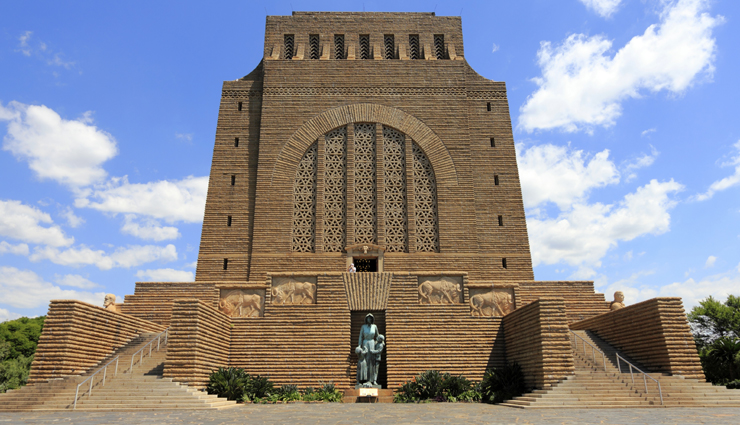
# Voortrekker Monument
The Voortrekker Monument is a prominent historical and cultural landmark located in Pretoria, South Africa. Here's some information about the Voortrekker Monument:
- Commemoration of Afrikaner History: The Voortrekker Monument was built to commemorate the history and struggles of the Voortrekkers, who were early Afrikaner pioneers and settlers. The monument serves as a symbol of Afrikaner nationalism, resilience, and the Great Trek, which was the mass migration of Afrikaners in the 19th century.
- Architectural Design: The monument was designed by architect Gerard Moerdijk and completed in 1949. It is an impressive structure that combines elements of classical, Gothic, and Art Deco architectural styles. The monument is characterized by its towering granite structure, with a central dome and four corner towers. It stands at an elevation, providing panoramic views of the surrounding area.
- Historical Panels and Hall of Heroes: Inside the monument, visitors can explore the Hall of Heroes, which features historical panels and sculptures depicting key events and figures from the Voortrekker history. The panels portray significant moments such as battles, treaties, and the hardships faced by the Voortrekkers during their journey.
- The Cenotaph: At the heart of the monument's main hall, there is a cenotaph, a symbolic tombstone honoring the Voortrekker leaders. The cenotaph is adorned with symbolic artwork and inscriptions that pay tribute to their courage and sacrifice.
- Museum and Exhibitions: The Voortrekker Monument houses a museum that showcases artifacts, documents, and displays related to the Voortrekker history. Visitors can learn about the lifestyle, culture, and challenges faced by the Voortrekkers through interactive exhibits and informative presentations.
- Cultural Events and Gatherings: The Voortrekker Monument serves as a venue for cultural events, concerts, and gatherings that celebrate Afrikaner heritage and history. It is particularly significant during the annual Day of the Vow (or Day of Reconciliation) on December 16th, which commemorates the Battle of Blood River in 1838.
The Voortrekker Monument holds cultural, historical, and symbolic significance for the Afrikaner community in South Africa. It stands as a testament to their identity, endurance, and the spirit of independence. The monument provides a glimpse into the history of the Voortrekkers and offers visitors an opportunity to explore their legacy and the impact they had on the development of South Africa.





